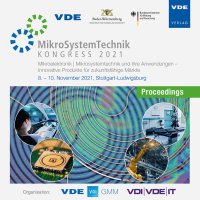Simulation model and dimensioning of a photoacoustic sensor for the detection of radiation-induced pressure surges
Konferenz: MikroSystemTechnik Kongress 2021 - Kongress
08.11.2021 - 10.11.2021 in Stuttgart-Ludwigsburg, Deutschland
Tagungsband: MikroSystemTechnik Kongress 2021
Seiten: 4Sprache: EnglischTyp: PDF
Autoren:
Handte, Thomas (Fachgebiet Technische Optik and IMN, Technische Universität Ilmenau, Ilmenau, Germany & 5microns GmbH, Ilmenau, Germany)
Bohm, Sebastian; Runge, Erich (Fachgebiet Theoretische Physik I and IMN, Technische Universität Ilmenau, Ilmenau, Germany)
Goj, Boris; Dittrich, Lars (5microns GmbH, Ilmenau, Germany)
Mollenhauer, Olaf (Kompass GmbH, Ilmenau, Germany)
Sinzinger, Stefan (Fachgebiet Technische Optik and IMN, Technische Universität Ilmenau, Ilmenau, Germany)
Inhalt:
In this article, a simulation model for a gas sensing system is investigated that couples electromagnetic, fluid mechanical and thermodynamic physics involved in photoacoustic phenomena. The effect of photoacoustics is based on the formation of sound waves (changes in pressure) in a closed volume. The energy resulting from the absorption of irradiated light in a gas volume leads to heating of the gas and is detected in a closed volume as a pressure change. The amplitude of the pressure wave depends on the type of molecular vibration as well as on the composition of the gas mixture. We present a fully coupled, multiphysics simulation model that provides a detailed description of a photoacoustic gas sensor. The modeling as well as the dimensioning of the system is challenging due to the coupling of the light absorption with the fluidic and thermodynamic domains. The highly different time scales on which optics and fluidics takes place and the various material properties require an efficient simulation method. In this paper, we present a simulation method for the dynamic behavior of an entire photoacoustic system. The heating of the gas caused by the radiation and the resulting expansion is described by means of a non-isothermal compressible flow. Effects such as the absorption of radiation in the chamber walls, the heat conduction within the solids as well as the concentration- and wavelength-dependent absorption properties of the gases are accounted for. The propagation of the electromagnetic radiation is described by means of a time-resolved ray tracing simulation. The fluid mechanical and thermal effects are subsequently coupled to the ray simulation and regularly updated after appropriately chosen time steps. The simulation results allow to identify the most relevant parameters for the enhancement of the sensor signal and to study their influence. The validation and discussion of the results of the theoretical model is carried out for material and design parameters typical for greenhouse gases.


